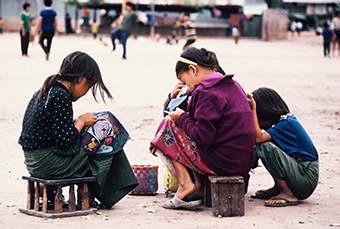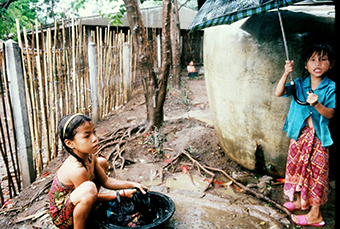This is the tenth in a series about the Hmong refugee and resettlement experience, part of a project by Minors*. Photos are from Chiang Kham and Ban Vinai refugee camps, northern Thailand, in the 1980s. Text and photos Copyright by Minors.
Wandering the winding footpaths and dirt roads in the Hmong refugee camps in northern Thailand decades ago, one encountered men and women busily going about their daily tasks, as we saw in the last installment of this series*. Another level of work activity was just as evident in camp, the everyday chores of children.
A lot of youngsters were lucky enough to attend schools in the camps, and most found some time for play, and we will look at their typical days in a future installment. The photos here give a glimpse of the hard work and important responsibilities that were a big part of children’s lives in camp.
In the Center One market in Ban Vinai camp a twelve-year-old boy set up shop next to some dis-used water tanks, selling kerosene in plastic bags, a common fuel in camp for lanterns, as there was no electricity throughout the camp, save for UN and Thai government and assorted offices and the hospital. Across the road a girl appearing barely five-years-old sold bread, keeping a strict count and a sharp eye on her customer.
Nearby a boy selecting some oranges at a stall, and like many other boys and girls with a younger sibling on his back. Around the corner another boy with a baby on his back as well, not the least bit deterring or distracting him while playing with his friends. Down the road at the hospital, a young barefoot girl walks by with a baby on her back, nearly as big as she is.
In the heart of the mid-day sun a girl with a full load strapped to her back made her way up a hill. On a rare rainy day in the dry season in Center Three, two girls washed clothes using the run-off from a nearby roof.
In Chiang Kham camp, in Payao province in northwestern Thailand, the scenes were similar
On a broiling day a young boy carried sugarcane over his shoulder and two young boys tried their luck going for a catch in a small creek in camp. Any extra protein was welcome, and many kids looked for edible critters and hunted birds with slingshots.
In our interviews with folks who were youngsters when they were in the camps thirty and forty years ago, some recall the misery of being hungry and sometimes getting sick and the tough existence and the constant toil. But some also remember it as a time that was often enjoyable, especially for younger children who were oblivious as to why they and their families were in a camp, with freedom to explore and play for long hours with friends.
On a windy day while boys play soccer all around them, girls hunker down to do needlework, and a girl works on her paj ntaub with a rather large younger sibling in her lap.
In a future installment we will look at the paj ntaub “industry” in the Hmong camps.
Photos were taken in the 1980s in Ban Vinai and Chiang Kham refugee camps.
Know anyone in these photos? Please ask them to contact us: admin@minorsasia.org
Or: Minors, Box 17131, St. Paul, MN 55117
*This series of articles about the Hmong refugee and resettlement experience is part of our project to develop educational materials in Hmong and English and traveling photo exhibits for schools and organizations in Minnesota, to help preserve Hmong heritage and history. This project will support our work in Asia. Please take a look: https://www.minorsasia.org/
Text and photos Copyright by Minors, a 501c3 organization based in St. Paul, working since 1990 to support Hmong and other highland ethnic minority children at remote mountain schools in Viet-Nam and Laos. From the early 1980s onward, we provided resettlement and other assistance to hundreds of orphaned Hmong children (Menyuam Ntsuag) at Ban Vinai, Chiang Kham, Panat Nikhom and Wat Thamkrabok refugee camps in Thailand.
















